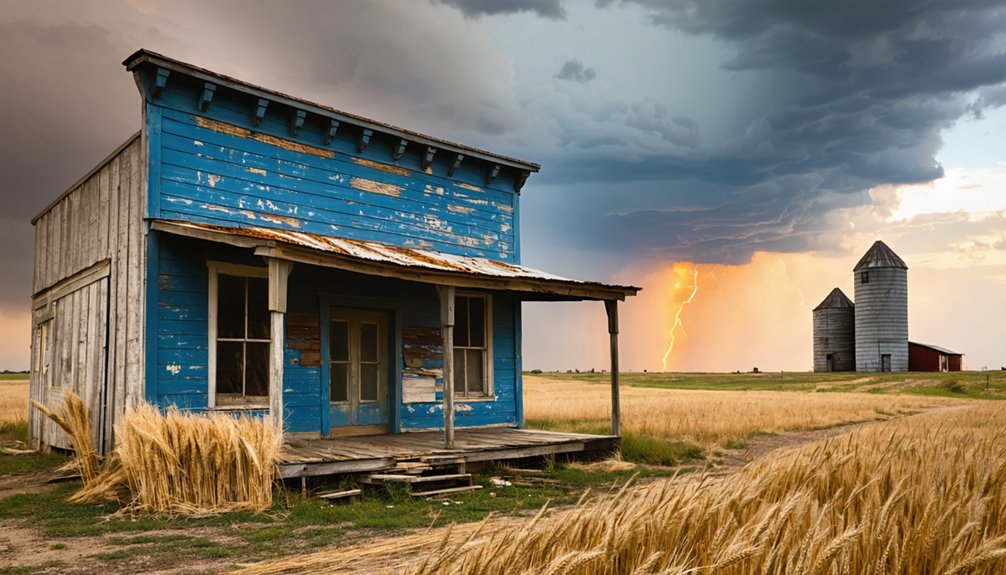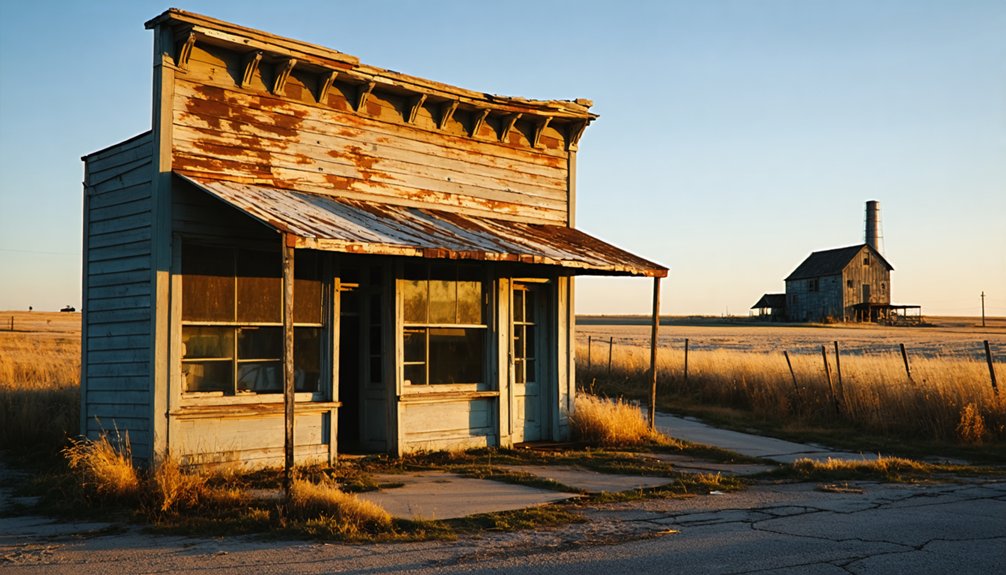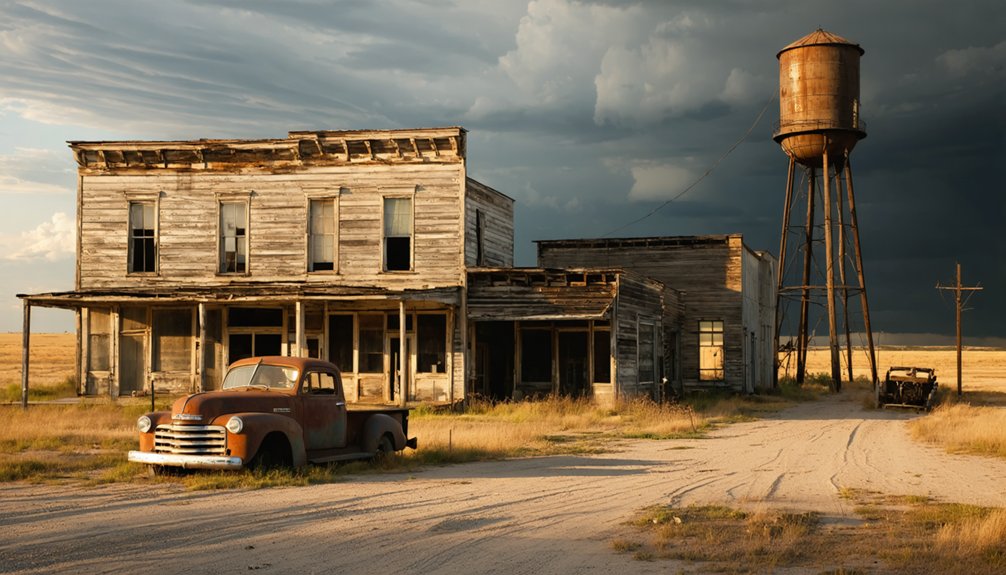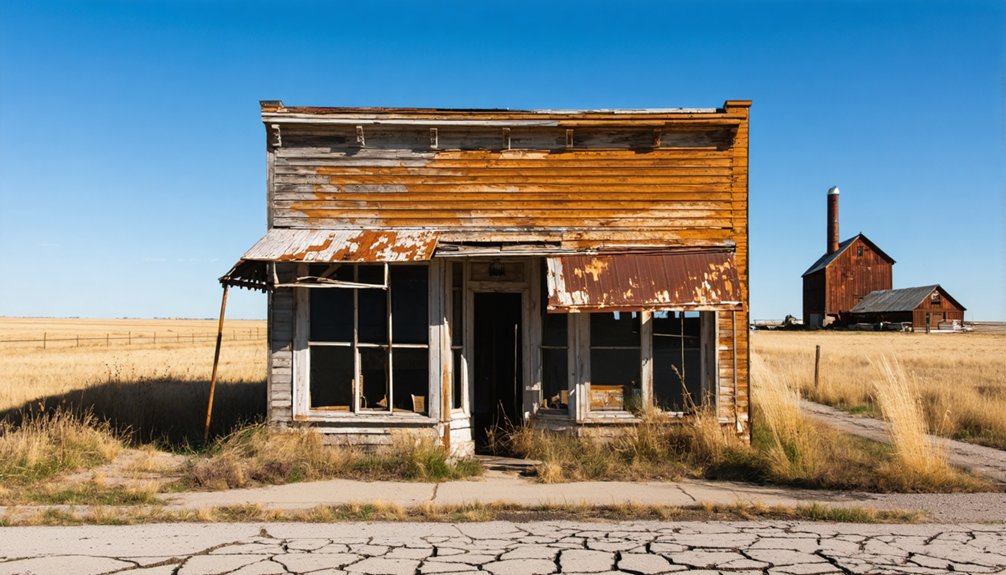You’ll find Moon, South Dakota tucked away in the Black Hills region, where it emerged as a frontier settlement in 1910. Named after first settler Jack Moon by T.J. Sherwood, this prairie community thrived around its post office and general store until 1953. Today, you can spot the remaining foundations at Boles Canyon Rd and Six Mile Rd, though the site’s now a private elk hunting retreat. Moon’s untold stories of frontier life and community resilience await beneath its quiet ruins.
Key Takeaways
- Moon was established in 1910 by T.J. Sherwood and named after Jack Moon, the first settler in the area.
- The town’s post office operated from 1911 to 1953, serving as a vital community hub before the settlement’s decline.
- Located at Boles Canyon Rd and Six Mile Rd, Moon’s remaining foundations are visible but access is now restricted.
- The site has been transformed into a private elk hunting retreat, with only traces of its former structures visible.
- Economic pressures and residents shopping in larger towns led to Moon’s abandonment by the mid-20th century.
The Rise of a Prairie Settlement

As pioneers pushed westward across the American frontier in the late 19th century, Moon emerged as one of countless prairie settlements dotting the South Dakota landscape.
Like many similar towns that became ghost towns, Moon faced the harsh realities of frontier settlement and economic uncertainty.
You’d have found the settlement dynamics typical of the era, with homesteaders drawn to the promise of available land for farming and ranching opportunities. The town’s early growth centered around essential services you’d expect – a general store, post office, and blacksmith shop. Researchers have meticulously documented Moon’s history on index cards along with hundreds of other abandoned settlements.
Like many prairie towns, Moon’s community resilience showed in its rapid development of social institutions.
You’ll recognize the pattern: boarding houses sprang up alongside mercantiles, while churches and schools established roots. The town’s founders banked on the railroad’s arrival, knowing it’d be vital for connecting their agricultural products to distant markets and ensuring the settlement’s long-term survival.
Jack Moon’s Legacy and Town Origins
You’ll find Moon, South Dakota’s origins intertwined with Jack Moon, the town’s first settler whose presence in 1910 led T. J. Sherwood to name the new settlement in his honor.
While Jack Moon’s background and contributions remain largely undocumented, his status as the initial resident established a lasting legacy that persisted until the town’s decline into a ghost town following its post office closure in 1953.
Unlike Earth’s Moon, which reaches extreme surface temperatures of 120°C to −171°C, the South Dakota town experienced typical continental climate variations.
Like Earth’s only natural satellite that takes 27.3 days to orbit our planet, the naming practice reflected the frontier tradition of recognizing early settlers, though Moon’s impact appears limited to his role as the community’s first inhabitant rather than any recorded civic leadership.
First Settler’s Impact
The pioneer legacy of Jack Moon profoundly shaped Moon, South Dakota‘s establishment and early development. His settler contributions laid the groundwork for what would become a significant hub for ranchers, fur traders, and prospectors in Pennington County.
You’ll find his pioneering spirit reflected in the town’s very name, chosen by T.J. Sherwood during the official town planning in 1910. The location thrived with the addition of a busy general store and bar.
Moon’s early presence helped establish the foundation for important infrastructure, including a post office in 1911 that connected the isolated frontier community to the wider world. His settlement near the intersection of Boles Canyon and Six Mile Roads proved strategically important, creating a natural gathering point that attracted additional settlers and commerce.
While the town eventually became a ghost town, Moon’s influence on the region’s development remains an essential part of Black Hills history.
Town Naming Origins
Building upon Jack Moon’s settlement legacy, the town’s naming history stands remarkably straightforward in Black Hills lore.
When T. J. Sherwood laid out the town in 1910, he recognized Jack Moon’s status as the first inhabitant by naming the settlement in his honor. Unlike many Black Hills communities named after mines, creeks, or railroads, Moon’s historical context reflects a direct connection to its pioneer resident. Like many ghost town hunting efforts, finding accurate historical records about these early settlements requires extensive research.
While details about Jack Moon himself remain scarce, his lasting impact on regional geography endures through the town that bears his name. A log building remains as one of the few visible remnants of the original settlement.
You’ll find no competing stories or alternate explanations for the town naming – official records confirm the post office’s establishment in 1911 simply as “Moon,” a designation that remained unchanged throughout its 42-year operation.
Early Settlement Planning
Despite Jack Moon’s namesake status, Moon’s initial settlement planning primarily focused on creating a functional hub for the region’s ranchers, fur traders, and prospectors.
You’ll find that early settlement patterns revolved around establishing crucial services near the intersection of Boles Canyon Rd and Six Mile Rd, where the town’s founders strategically positioned key structures.
The community infrastructure included essential establishments that served both residents and travelers: a general store for supplies, a post office for communication, a bar for social gatherings, and a campground for temporary lodging.
Like many other abandoned towns in the area, Moon eventually became a ghost town destination for photographers and history enthusiasts.
While Jack Moon’s personal contributions aren’t well-documented, the town’s practical layout reflected the practical needs of its time, creating a self-sufficient outpost that supported the area’s diverse economic activities.
Like many South Dakota settlements, Moon was strategically placed seven miles from the nearest railroad town to maximize accessibility and economic potential.
Life in Early Moon (1910-1953)
In early Moon, you’d find the post office serving as the heart of the community, where locals gathered to collect mail and exchange news from 1911 until its closure in 1953.
First settler Jack Moon’s pioneering spirit set the tone for the town’s development, as his homestead became the foundation for T.J. Sherwood’s planned community.
While specific business records remain scarce, the post office’s long-running operation suggests Moon maintained enough economic activity to support basic services and commerce for several decades. Just as Earth’s moon lacks a significant atmosphere, the town of Moon gradually faded into a ghost town with little remaining infrastructure.
Post Office Hub Days
Moon’s post office emerged as the town’s crucial community hub when T.J. Sherwood laid out the settlement in 1910.
You’d find the post office, established in 1911 and named after first settler Jack Moon, operating from a local general store where it served as more than just a mail center. It’s where you’d catch up on local news, collect your newspapers, and maintain essential connections to the outside world.
During its 42-year run, this post office was your lifeline through two World Wars and the Great Depression, joining 822 other post offices that dotted South Dakota at their peak in 1911.
When you needed government documents or wanted to ship goods, this community connection point made it all possible until its closure in 1953, marking the beginning of Moon’s decline into ghost town status.
Early Business Operations
While homesteaders and ranchers gradually settled the area, Moon’s bustling commercial district took shape around 1910 with essential businesses that you’d expect in an early frontier town.
You’d find a general store stocked with crucial supplies, from farming tools to clothing, where locals traded and bartered for business sustainability. The town’s tavern wasn’t just a place for drinks – it served as a hub for social interactions where you could catch up on local news and meet fellow settlers.
A campground provided rest for travelers and hunters, while ranching support services kept the agricultural community connected. These businesses worked together to maintain Moon’s economic significance until the 1920s, when changing times began to chip away at the town’s commercial foundation.
First Settler Jack Moon
The frontier town’s namesake, Jack Moon, established his homestead in the early 1900s, marking the first permanent settlement in what would become Moon, South Dakota. His settler experiences laid the groundwork for the community’s development, which formally began when T.J. Sherwood planned the townsite in 1910.
As the area’s pioneer resident, Moon’s presence attracted other settlers, shaping early community dynamics and contributing to the town’s identity.
You’ll find Jack Moon’s influence woven into the fabric of early Moon, SD, as his homestead became the nucleus around which basic services emerged.
The establishment of a post office in 1911 and essential businesses like the general store reflected the growing settlement that took root around Moon’s original claim.
The Last Days of a Frontier Town
As economic pressures mounted in the mid-20th century, frontier life in Moon, South Dakota gradually faded into obscurity.
You’d have witnessed the economic changes as automobiles made it easier for residents to shop in larger towns like Rapid City and Newcastle.
The town’s cultural decline accelerated when supporting industries – mining, agriculture, and fur trading – couldn’t sustain the community.
What Remains Today

Standing quietly at the intersection of Boles Canyon Rd and Six Mile Rd, Moon’s remaining structures tell a story of frontier life gone silent.
Today’s remnants analysis reveals a ghost town frozen in time, though private ownership restricts your ability to explore up close.
If you’re planning to visit Moon, you’ll find:
- Original building foundations and deteriorating structures visible from public roads
- A transformed landscape that now serves as a private elk hunting retreat
- Historical echoes of the town’s heyday, including the former locations of the general store, bar, and post office
While you can’t access the site directly, you can still glimpse these physical reminders of South Dakota’s frontier past from nearby roads, where Moon’s buildings stand as silent sentinels of a bygone era.
Ghost Towns of the Black Hills Region
Moon’s quiet remnants mirror dozens of similar settlements scattered throughout the Black Hills region, where abandoned towns tell tales of South Dakota’s gold rush era.
You’ll find these ghost towns in various states of preservation, from completely vanished sites like Camp Crook, now submerged beneath Pactola Lake, to partially inhabited places like Silver City with fewer than 100 residents.
While exploring the region’s mining history, you’ll discover abandoned hard rock mines marked by towering headframes, crumbling ore bins, and weathered cyanide vats.
Ancient mining relics pierce the landscape – stark headframes, deteriorating bins, and worn cyanide vats tell stories of forgotten fortunes.
Places like Spokane, Astoria, and Trojan showcase the remains of once-bustling mining operations.
Though time has taken its toll on many structures, ghost town preservation efforts help maintain these physical connections to the Black Hills’ golden past.
Historical Significance and Preservation

While many ghost towns in South Dakota have preservation efforts dedicated to their legacy, Moon’s historical significance remains largely untouched since its abandonment.
As part of the state’s cultural heritage, Moon tells a compelling story of the rise and fall of rural communities in the early 20th century.
While there’s no formal historical preservation plan in place, you’ll find that Moon’s history is preserved through:
- The documented records of its post office operations from 1911 to 1953
- The story of its founding by T.J. Sherwood and first inhabitant Jack Moon
- The town’s role in demonstrating the economic challenges faced by small South Dakota communities
Today, Moon stands as a symbol of the freedom and independence that drew settlers to establish communities in South Dakota’s frontier, even though these dreams were ultimately short-lived.
Frequently Asked Questions
Were Any Famous Outlaws or Historical Figures Known to Visit Moon?
You won’t find outlaw sightings or historical visitors in Moon’s story – while nearby Deadwood attracted Wild Bill Hickok and Calamity Jane, this quiet post office town never hosted any famous figures.
What Natural Disasters or Severe Weather Events Affected Moon’s Development?
You’ll find no records of flood damage or severe drought destroying Moon, but harsh winters and heavy snowfall regularly challenged residents, limiting road access and complicating farming during the town’s brief existence.
Did Moon Have a School, Church, or Other Community Buildings?
While you might expect typical frontier institutions, Moon only had a store, post office, and gas station. Community events and local traditions centered around informal gatherings with piano music and group singing.
What Was the Peak Population of Moon During Its Most Prosperous Years?
You won’t find exact population records for Moon’s peak years. While economic factors and population trends shaped the town’s destiny, historical data doesn’t reveal specific numbers from its most prosperous period.
Were There Any Mining or Industrial Operations Near Moon?
Like a ghost in the prairie wind, you won’t find any significant mining techniques or industrial operations near Moon. Historical records show no major mining activity or industrial decline in this area.
References
- https://en.wikipedia.org/wiki/Moon
- https://kids.kiddle.co/Moon
- https://www.youtube.com/watch?v=Glucs_Rq8Xs
- https://www.sdpb.org/rural-life-and-history/2023-08-21/some-black-hills-ghost-towns-and-their-origins
- https://en.wikipedia.org/wiki/List_of_ghost_towns_in_South_Dakota
- https://explore.digitalsd.org/digital/collection/WPGhosttown/id/4761/
- https://icatchshadows.com/okaton-and-cottonwood-a-photographic-visit-to-two-south-dakota-ghost-towns/
- https://www.powderhouselodge.com/black-hills-attractions/fun-attractions/ghost-towns-of-western-south-dakota/
- https://openprairie.sdstate.edu/etd/4061/
- https://aberdeenmag.com/2019/01/the-ghost-towns-of-brown-county/



